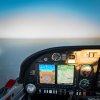True, but in a MedEvac situation isn't it often a concern of how the patient's body (not just SpO2) will react to the pressure change? Obviously it depends on the condition, but things like brain bleeds (and lots of other conditions) I understand require keeping a cabin pressure at a low altitude to prevent them getting worse or causing more damage.
At the relatively low altitudes that I fly in the 414, I don't worry about it a ton. But I do think I'll get my O2 bottle refilled and start carrying it along for these longer trips, especially if night flying is involved.


